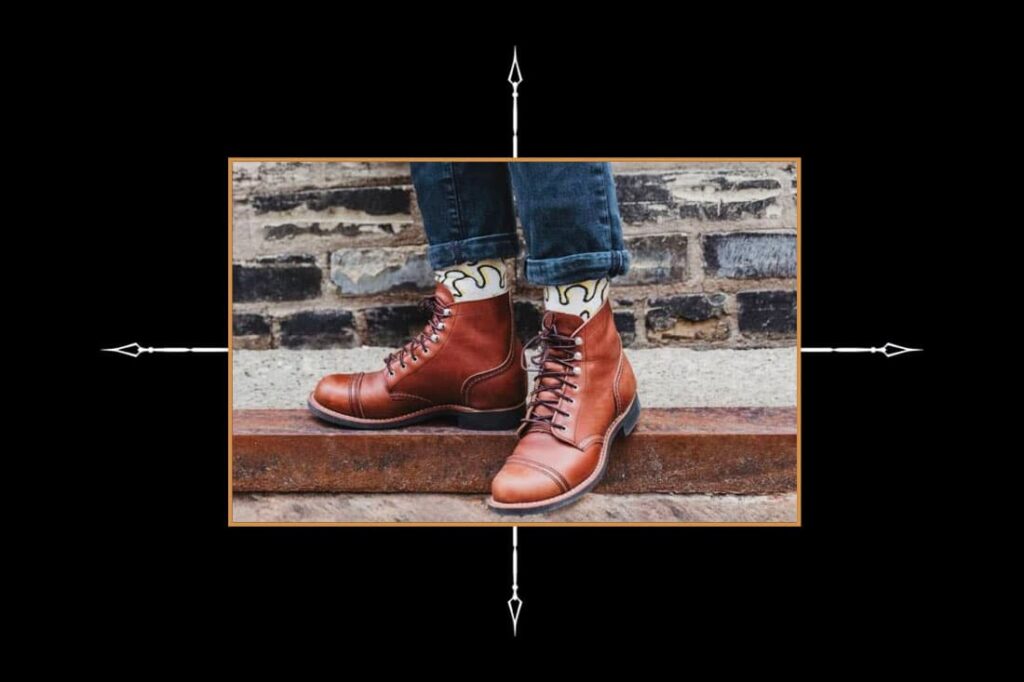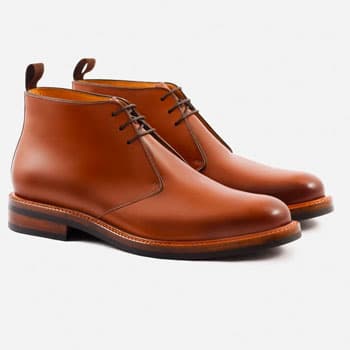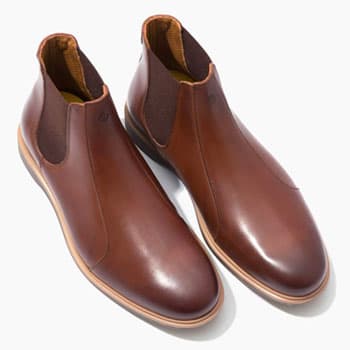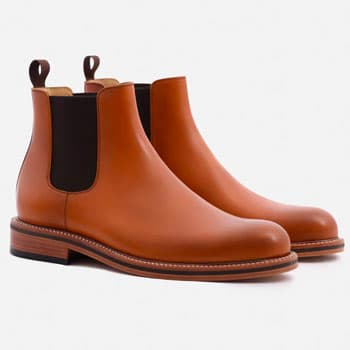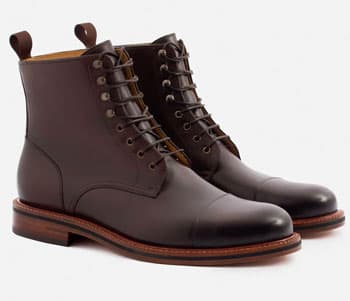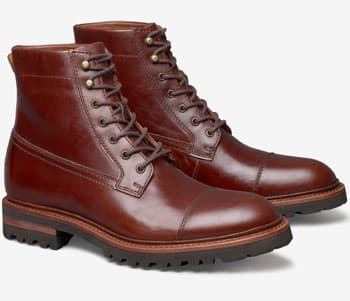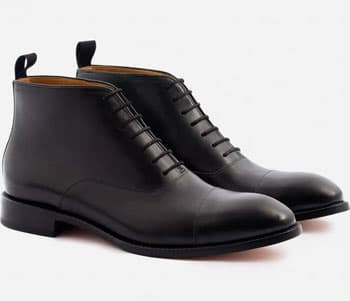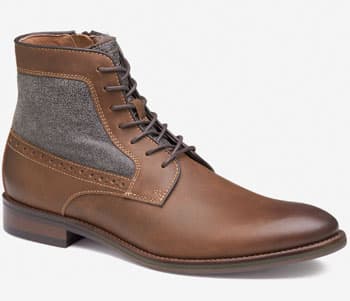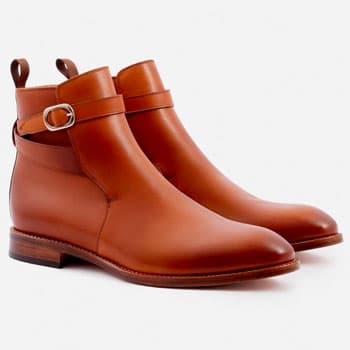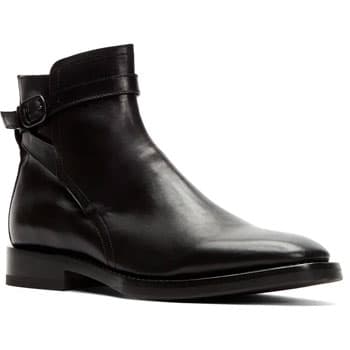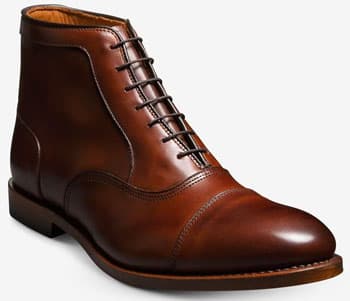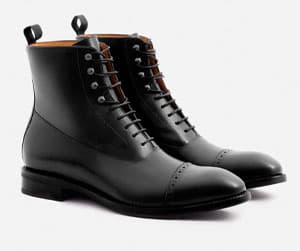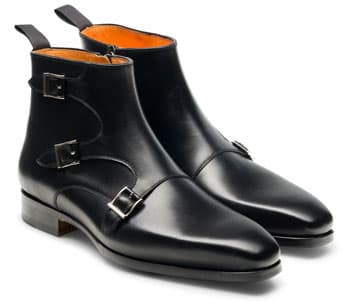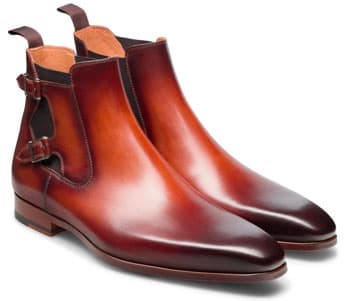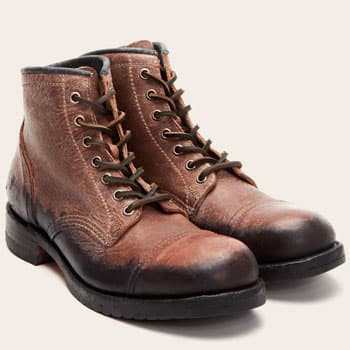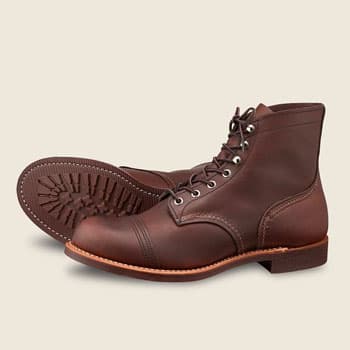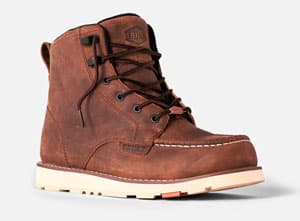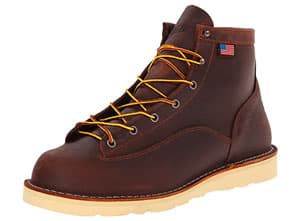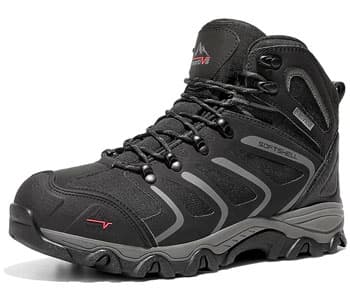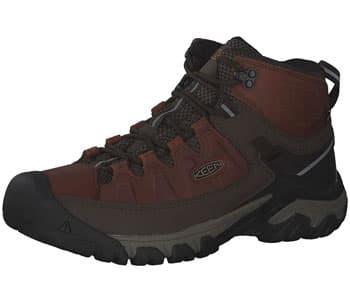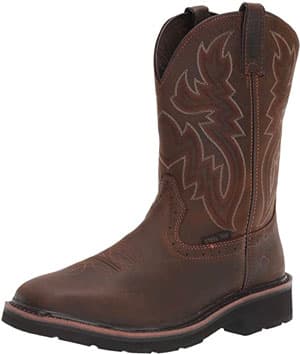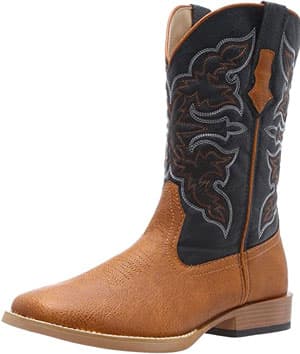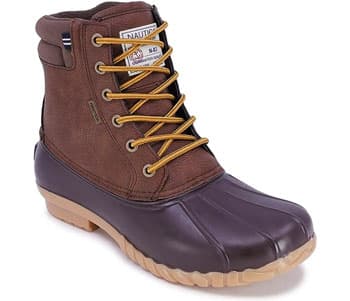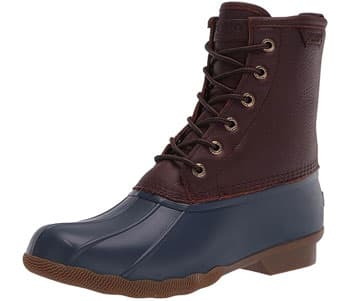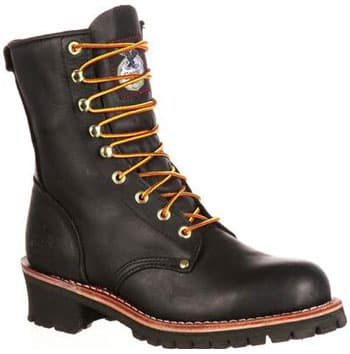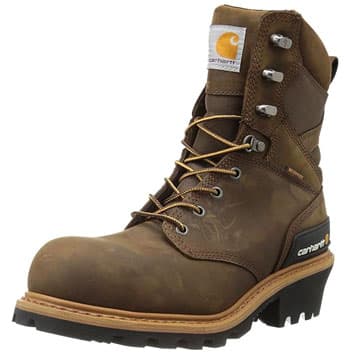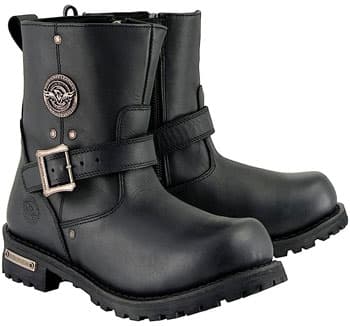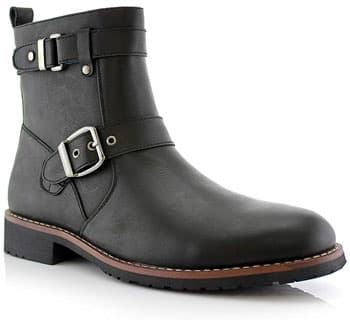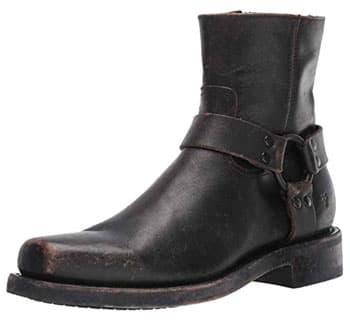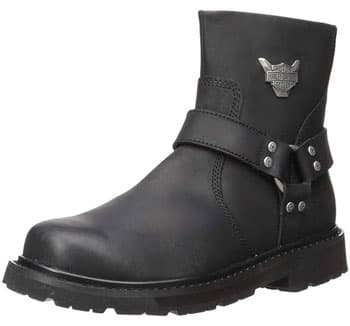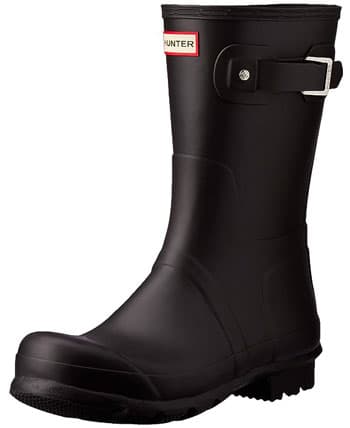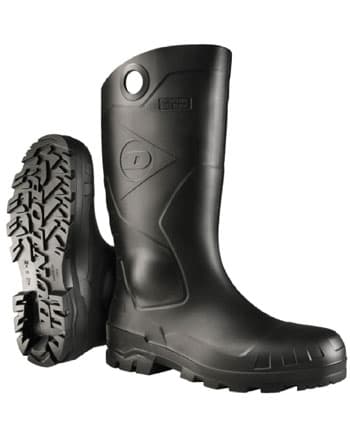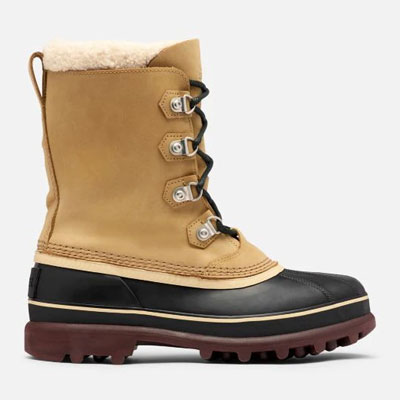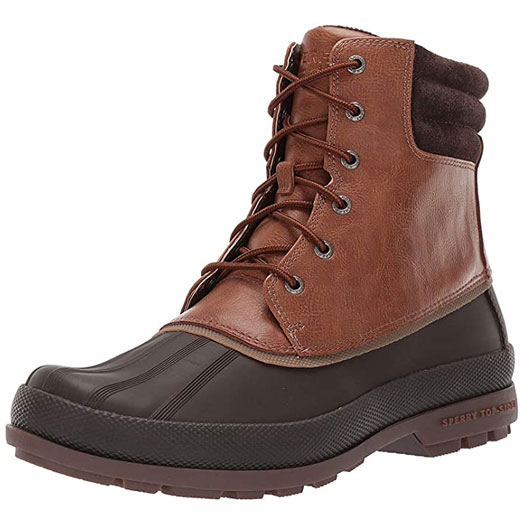Any guy looking for a new pair of boots could be forgiven for feeling overwhelmed by the sheer volume of men’s boots styles on the market.
Each year, usually starting in the fall, menswear brands roll out a ton of new releases, new colors and allegedly new styles.
But when you look closely at the new releases, it doesn’t take long before a clear pattern starts to emerge:
This year’s must-have boots look suspiciously similar to last year’s. And the year before that… And often even the decade before that.
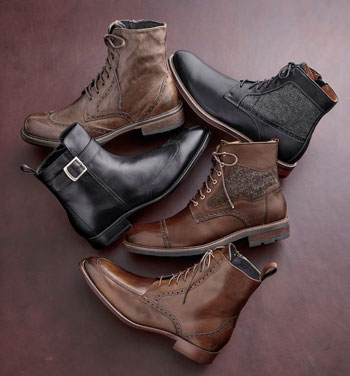
That’s because, while it may seem like there are a zillion types of boots for men, the truth is that the vast majority of them fall into the same small handful of tried, true and classic men’s boot styles.
And that’s good news, because once you know which fundamental styles will stand the test of time, choosing the right pair becomes a lot easier.
To help you (lame pun alert!) step up your boot game (you were warned), in this post I’ll lay out the sharpest, most classic men’s boot styles on the market, explain how to get the most out of each one, and share a few of my top picks in each category.
Types of Boots vs Styles of Boots
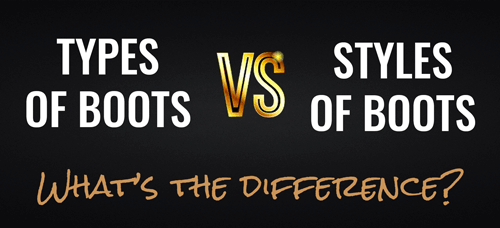
Before I go into detail about the most popular types and styles of boots, it’s worth taking a second to explain the difference between the two.
Types of boots refer to unique (and in most cases, mutually exclusive) categories that define a boot’s identity.
Styles of boots, on the other hand, refer to different ways that a type of boot might be designed.
For instance, an oxford is a type of boot because, much like oxford shoes, they’re defined by the fact that the shoelace tabs are attached underneath the vamp (aka the top of the boot).
But a cap toe boot is a style of boot because many different types of boots can come with a cap toe, including everything from a sleek oxford boot that you would wear with a suit to the heavy-duty work boots favored by construction workers.
To help keep things clear, below I’ve separated out the various types and styles of boots into their own categories, and further subdivided the types of boots into two subtypes:
Dress/casual boots, which are usually worn for the sake of style, and purpose-specific boots that are primarily meant for a particular task.
First Up ↓
Must-Have Types of Men’s Boots
Rounding Up the Most Essential Types of Boots Every Man Should Own
Dress Boots & Casual Boots
Chukka Boots, aka Desert Boots
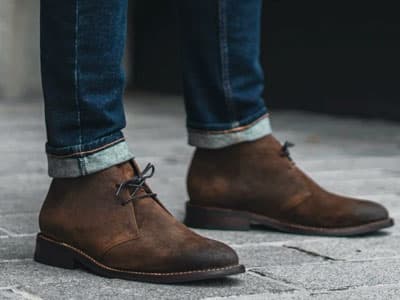
Defining Features:
- Ankle-high length
- Typically made of suede or leather
- Two or three pairs of eyelets for lacing
- Plain toe
- Thin soles, often made of crepe rubber
If you’re just starting to build out your footwear collection, chukkas are probably the first pair of boots you should add.
Ankle-high boots usually made with a leather or suede upper, chukkas were initially worn by British soldiers during World War II, and have remained a popular choice among style-conscious guys ever since.
(The phrase Chukka originally referred to a specific type of desert boot that resembled the specific boots worn in the Western Desert Campaign, but nowadays “chukkas” and “desert boots” are more or less interchangeable.)
Their defining feature is their crepe sole, a thin sole made of crepe rubber, which is essentially coagulated latex, or natural rubber.
Crepe soles have a distinctive, textured appearance that’s somewhat crinkled or wrinkled, giving them a sort of rugged or “raw” look, which evokes a rustic, natural and timelessly masculine aesthetic.
When and Where to Wear ‘Em:
- Casual outings
- Paired with chinos or jeans
- With rolled-up denim for a relaxed look
Chukka boots are a great choice for casual wear because they’re incredibly versatile.
They can be paired with everything from super laid back blue jeans to dressier chinos and khakis, and work just as well in a business casual setting as they do on date night.
They work great in the fall, but they’re probably the best men’s boots for warmer months thanks to their lightweight design.
Sharp Selections:
Chelsea Boots
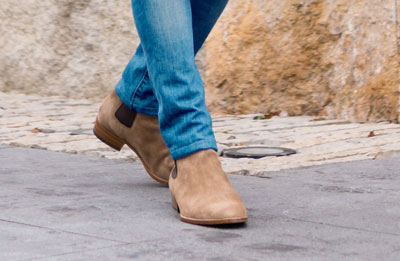
Defining Features:
- Ankle-high design
- Characterized by elastic side panel
- Pull tab at the back for easy on and off
- Streamlined appearance
- Often made of leather or suede
Chelsea boots are ankle-length boots that forego laces in favor of elastic side panels and a pull tab at the back.
Chelseas date back to the time of Queen Victoria and their invention is actually credited to her personal shoemaker, Joseph Sparkes Hall.
Though they were designed for the queen, they were quickly adopted by both men and women as a comfortable, slip-on alternative to the more restrictive boots of the era.
Over time, their sleek and minimalistic design has become a timeless fashion staple, and today a good pair of Chelsea boots appeals to a wide range of styles and subcultures, including everyone from trail-hiking outdoorsmen to suit-wearing city slickers.
When and Where to Wear ‘Em:
- Casual to semi-formal settings
- With jeans, chinos, or suits
- Suitable for both day and night outings
Chelsea boots are incredibly versatile and can be adapted to a wide range of settings, from extremely casual to very formal.
Their streamlined silhouette allows them to blend seamlessly with various styles, making them a valuable addition to any wardrobe.
In a more formal setting like an office or wedding, Chelseas with a refined toe shape can be paired with suits, dress pants and dress shirts, offering a sleek alternative to traditional dress shoes.
For casual getups, a classic Chelsea boot in leather or suede works well with jeans, chinos, and casual shirts or tees.
In these more relaxed settings, you can opt for a sharp toe shape to add a touch of refinement to your ‘fit, or go for the more rounded toe often found on popular models like Blundstones, which gives off a more workman-like vibe.
Sharp Selections:
Derby Boots
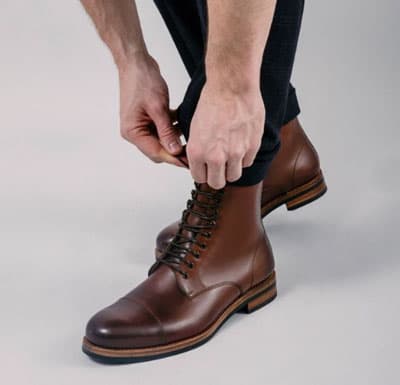
Defining Features:
- Open lacing system (eyelet tabs sewn on top of the vamp)
- Ankle-high
- Typically made of leather
- Often have a rounded toe
A casual staple, derby boots are similar to derby-style dress shoes, but with an ankle-high design.
Derby boots often feature leather soles and clean lines, making them suitable for smart casual looks.
When and Where to Wear ‘Em:
- Semi-formal to casual settings
- Paired with denim or proper trousers, chinos or khakis
- Suitable for office environments
Derbies are dress boots – especially by today’s more casual standards – but they’re not quite as dressy as oxford boots.
As a result, they’re a little less sophisticated, but much more versatile.
For instance, a pair of derbies with a dark brown leather upper can be paired with dark jeans for a smart-casual look that works during daytime at the office but looks just as sharp when you’re going out for a night on the town after work.
Sharp Selections:
Oxford Boots
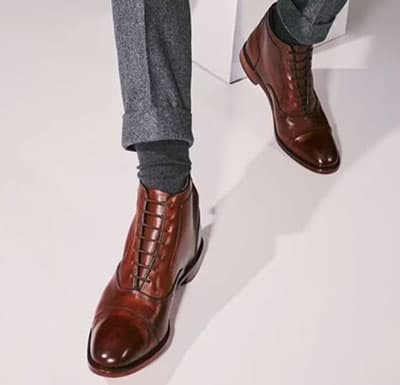
Defining Features:
- Closed lacing system
- Ankle-high or slightly above
- Streamlined and polished appearance
- Traditionally made of high-quality leather
Drawing inspiration from the Victorian era, these are a more formal variation of ankle boots.
Often constructed with leather uppers and thin soles, they add a sleek, sophisticated look to your get up that’s a little more “dressed up” than derbies (and a lot more dressed up than chukkas).
When and Where to Wear ‘Em:
- Formal events or office settings
- Worn with suits or dress slacks
- For a polished and professional appearance
Sharp Selections:
Jodhpur Boots
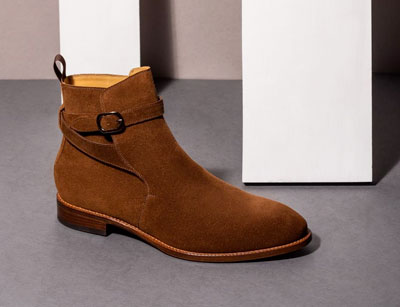
Defining Features:
- Ankle-high design
- Strap and buckle closure
- Typically made of leather
- Originated in India for riding
Jodhpur boots, often referred to simply as “Jodhpurs,” are a type of ankle-length boot that originated in India.
(They were initially designed for polo players in the city of Jodhpur, hence the name.)
Over time, they’ve become a popular footwear choice for equestrian activities, especially in horse riding events and shows.
But they’ve also made the leap from equestrian settings to urban ones, and been adopted by stylish guys looking for a rugged-but-still-refined alternative to the more popular types of ankle boots like chukkas and oxfords.
When and Where to Wear ‘Em:
- Equestrian events or casual outings
- Paired with slim trousers or riding pants
- Wear them as an alternative to oxfords for a less common, more refined look
With their equestrian roots, Jodhpurs are versatile and suitable for various occasions, from casual outings to semi-formal events.
You can pair them with jeans or chinos for a relaxed look, tailored trousers for a polished appearance, or even with suits to add a unique touch to more formal looks.
Sharp Selections:
Balmoral Boots
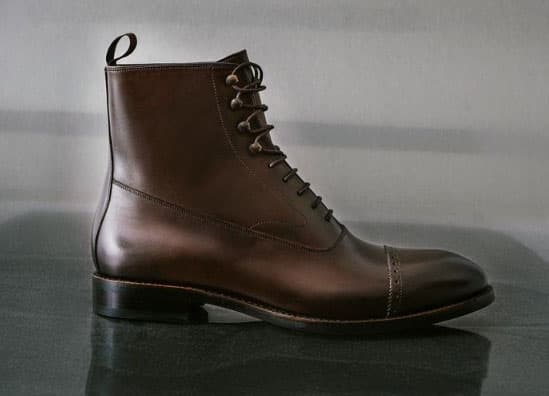
Defining Features:
- Closed lacing system, similar to Oxfords
- A more formal appearance
- Often have a two-tone design where the upper section is a different color or material
Sometimes referred to simply as “Bal boots,” Balmoral boots are a type of classic, elegant ankle boot characterized by their closed lacing system.
Originating in Scotland and named after Balmoral Castle, they feature a distinct line of stitching or “seam” that separates the upper part of the boot from the lower, often using two different types of leather or materials, and sometimes even two different colors.
The combination of the seam and the differing materials helps distinguish them from other dress shoes and boots, like Oxfords, making them a great choice for fashion-forward guys who want to distinguish themselves from the crowd.
When and Where to Wear ‘Em:
- Pretty much anywhere where you could wear Oxford boots
- Formal occasions
- Great for evening events or special occasions
- Best with a well tailored suit
Balmoral boots are most commonly associated with formal and semi-formal attire.
You can wear them with suits, tailored trousers, or even sharp-looking chinos.
Given their refined appearance, they’re also great for office settings, formal events, or any occasion where a polished look is desired.
Sharp Selections:
Monk Strap Boots
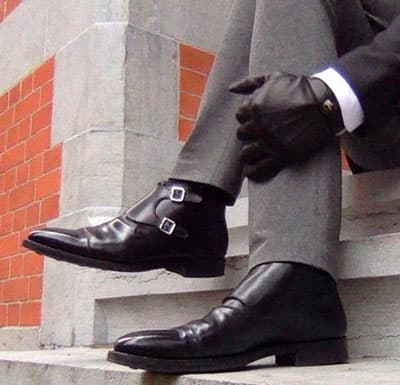
Defining Features:
- No lacing, instead uses buckled straps (single or double)
- Ankle-high
- Streamlined appearance
Monk strap boots are a type of footwear that merges the design of the traditional monk strap shoe with the structure of a boot.
Characterized by their absence of laces, monk strap boots use buckles – either single or double – as closures.
The buckle design is inspired by the footwear worn by European monks, which needed to be both durable and easy to slip on and off.
When and Where to Wear ‘Em:
- Semi-formal to casual gatherings
- Paired with tailored trousers or dark denim
- Like Jodhpurs, can elevate a smart-casual look and help you stand out from the crowd
Monks straddle the line between casual and formal, making them a versatile choice.
For formal occasions, they can be paired with suits or tailored trousers, adding a unique touch compared to regular dress shoes.
For more casual outfits, they work well with chinos or even dark denim, where the buckle design really helps them stand out and make a statement.
Sharp Selections:
Service Boots, aka Combat Boots
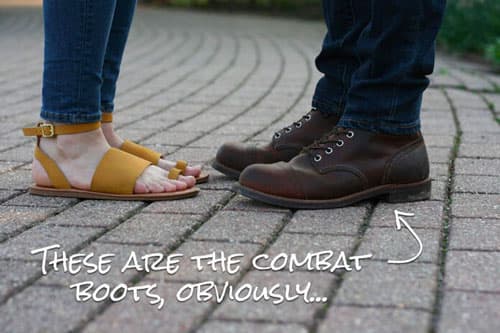
Defining Features:
- Robust and durable
- High-top design, typically above the ankle
- Lacing system can extend to the top of the boot
- Originally designed for military service, but now popular in fashion as well
Like chukkas, service boots – often referred to as combat or military boots – have roots in the military.
They were originally designed as multi-purpose leather boots that would serve soldiers in various conditions, providing durability and protection.
Characterized by their rugged build and ankle-length or higher design, they often come with a cap toe detail (on which more below), and are constructed to handle wear and tear while ensuring comfort.
When and Where to Wear ‘Em:
- Casual wear or urban exploration
- Paired with casual pants like cargo pants, jeans, khakis and chinos
- Can also be paired with a leather jacket or field jacket for a rugged appearance that evokes their military origins
They’re a popular choice because they lend a rugged and masculine vibe to the types of pants that most guys already have in their wardrobes, including jeans, cargos, chinos and khakis.
With that said, it’s worth noting that they’re definitely on the more casual side—these aren’t the best boots for pairing with a suit or a good pair of dress pants.
Instead, they go well with casual staples like flannel shirts, tees, or casual jackets.
They’re a favorite for winter months thanks to their robustness, and can (almost) be worn year-round in places like the Pacific Northwest or the Northeast, where boot season often tends to stretch from September to April.
Sharp Selections:
Purpose-Specific Boots
As the name of this section implies, each boot style below is designed to serve a specific function, like working on a ranch, trudging through snow or riding a motorcycle.
But with that said, many of them can be repurposed into casual boots that will lend your look a certain rugged appeal, even if you wear them outside of their intended setting.
Work Boots
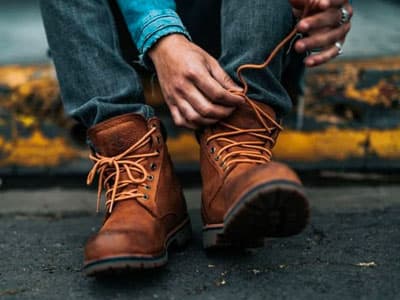
Defining Features:
- Durable and often heavy-duty
- Traction-focused soles
- Ankle to mid-calf length
- May have steel toes or other safety features
Another type of boot whose name more-or-less sums it up, work boots are sturdy footwear designed primarily for labor-intensive tasks and jobs that require enhanced protection for the feet.
These boots often feature reinforced toes (like steel toes), durable materials, and slip-resistant soles.
They prioritize functionality, safety, and comfort, especially for prolonged wear in demanding environments such as construction sites, factories, and farms.
When and Where to Wear ‘Em:
- On job sites or when completing heavy-duty tasks (obviously)
- In casual settings where you might otherwise wear boots like chukkas or service boots
- Paired with work pants or jeans
While they were originally designed for job sites, their hard-knock appeal has made rugged work boots a fashionable choice for everyday wear.
For casual settings, lighter boots that don’t have a heavy safety toe can be paired with jeans, khakis, or casual trousers to give you a grounded, hard-working vibe.
Flannel shirts, jackets, and vests all complement this aesthetic, but you want to be a bit careful here.
It’s one thing to give your look coherence by wearing clothes that all give off the same vibe.
But if you lean into the look too much, you run the risk of looking less like a casually stylish man and more like a Village People cosplayer.
Sharp Selections:
Hiking Boots
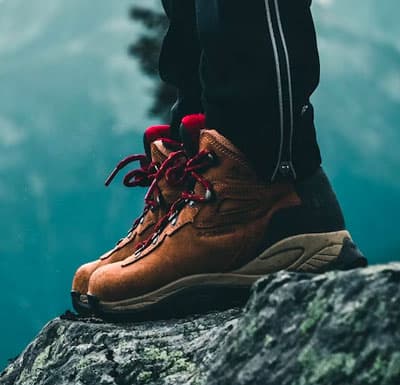
Defining Features:
- Built for traction on rough terrains
- Ankle support
- Often waterproof or water-resistant
- Durable construction with reinforced toe and heel areas
Hiking boots are specialized footwear designed for trekking in outdoor environments, particularly on rough terrain like mountains, forests, and trails.
They prioritize support, especially around the ankles, traction for various surfaces, and durability against elements like water, mud, and rocks.
They often feature a high-top design, robust soles with deep treads, and are usually made of materials that are both rugged and breathable.
When and Where to Wear ‘Em:
- Outdoor trails or treks
- Can be worn with shorts or long pants
- Worn with durable, breathable clothing
- Paired with hiking socks for added comfort
While hiking boots are fundamentally designed for outdoor treks, they’ve gained (time for another pun) traction (ugh—I’m the worst) in everyday casual style thanks to their rugged look and undeniable comfort.
They’re obviously great for outdoor activities, like hikes, treks, or any adventure where the terrain might be unpredictable.
It’s harder to pull them off in casual urban settings, but they can sometimes be worn with jeans or cargo pants, complemented by casual shirts or jackets.
Their chunky design can be something a statement in and of itself, so it’s good to keep the rest of the outfit relatively simple.
Sharp Selections:
Cowboy Boots
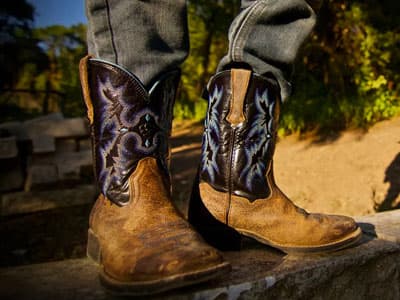
Defining Features:
- Pointed toe
- High heel
- Decorative stitching
- Typically come up mid-calf
- No laces, slip-on design
Cowboy boots, also sometimes called Western boots, are a distinctive style of riding boot that originated in the American West.
They typically have a high shaft, a Cuban heel, and a pointed or rounded toe.
Notable for their unique decorative stitching, intricate designs, and sometimes vibrant colors, cowboy boots tend to come in two varieties:
There’s the no-nonsense and hard-working kind that are appropriate for actually working on a farm or ranch, and the more stylish kind that often have eye-catching patterns on the shaft, and sometimes have a sharper toe shape that gives them a more formal look.
When and Where to Wear ‘Em:
- Country events or casual outings (particularly in the American West and Southwest)
- Best paired with denim jeans, but can also work with trousers
Of all the various style and types of boots on this list, none are as regionally specific as cowboy boots.
They have deep Western roots, and while they’re still a common style found on a daily basis in the American West, you’re unlikely to see them very often in other places.
Traditionally, they’re worn with denim jeans, Western or flannel shirts, and wide-brimmed hats.
But in contemporary fashion they can be paired with a range of casual pieces, like jeans and chinos, and even with more formal attire like a blazer and bolo tie.
With cowboy boots, the key is to wear them with confidence—and authenticity.
If you like the look but don’t think you have the right overall style – or right geographic location – to wear them authentically, then don’t.
It’s one thing to live in the West and grow up surrounded by people for whom cowboy boots and 10-gallon hats are the real deal.
It’s quite another to watch Yellowstone and think, “Huh… should I try cowboy boots?”
The answer, unfortunately, is probably no.
Sharp Selections:
Duck Boots
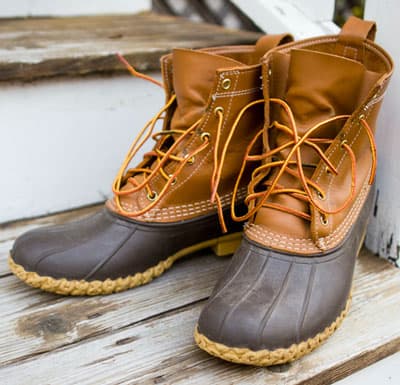
Defining Features:
- Waterproof rubber sole and lower section
- Upper usually made of leather or another waterproof material
- Laced front
- Designed for wet conditions
Duck boots are a specific type of waterproof boot designed to withstand wet conditions.
(They’re also sometimes referred to as “bean boots” because they were popularized by retailer L.L. Bean.)
Whereas most boots only have a rubber sole, with duck boots the entire lower section of the boot is usually made from rubber, making them ideal for rainy or snowy weather.
The design ensures your feet remain dry, combining functionality with a distinctive (if not exactly fashion-forward) style.
When and Where to Wear ‘Em:
- Wet, slushy conditions
- With rain jackets or other waterproof gear
- Paired with jeans or chinos
Duck boots are primarily a practical choice for inclement weather, especially during rain or slushy snow conditions.
If it’s pouring rain and you don’t want to get your best pair of suede boots wet, you can stash them in your bag and throw on a pair of ducks to get to the office.
But while they’re made for function first and fashion a distant second, their unique aesthetic and popularization by L.L. Bean has actually made them something of a fashion statement.
As a result, you sometimes see them integrated into urban and casual outfits even when the weather isn’t particularly bad.
Due to their bulky nature, they tend to work well with slightly relaxed or straight-fit pants, especially when the hem rests comfortably over or just inside the boot’s shaft.
But if you’re still rocking slim or skinny jeans, fear not: a chunky pair of ducks can still work well, they’ll just be even more distinctive.
Sharp Selections:
Logger Boots
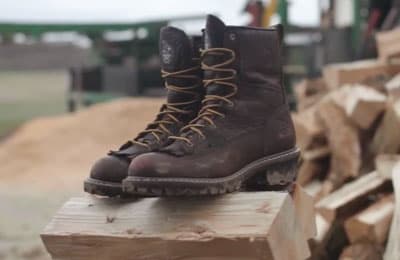
Defining Features:
- Designed for logging work
- High-top with significant ankle support
- Deep lug soles for traction
- Steel-toe options available
- Provides safety in challenging terrain
Logger boots are a specific type of work boot designed primarily for… well, loggers.
They’re characterized by their tall design, which provides support to the ankles, and aggressive tread patterns that provide traction on uneven and potentially slippery terrains.
They traditionally come with a defined heel, steel toe for protection, and are made of durable materials to withstand the harsh environment and rigors of logging.
When and Where to Wear ‘Em:
- Wilderness jobs or outdoor work
- Paired with workwear and fall or winter staples like chunky sweaters and flannels
Much like work boots and military boots, loggers have transcended their original purpose thanks to their undeniably rugged looks and fairly bad-ass origins.
Given their robust construction, loggers are too heavy and chunky for light casual wear or formal settings.
These are heavy-duty boots best worn during cooler months, when they can be paired with jeans and other fall staples like a thick shawl collar cardigan, a good flannel shirt or a heavy jacket to create getups that are as rugged as they are timeless.
I’m tempted to issue another disclaimer about not overdoing it here, and warn you against going full lumberjack by pairing logger boots with jeans and a flannel.
But the lumbersexual look has been around for about a decade now and demonstrated some surprising staying power, likely because it’s easy, timeless and masculine as hell.
(Plus, I’m Canadian, and even though I haven’t looked this up, I’m pretty sure it’s illegal for me to tell people not to dress like lumberjacks.)
Sharp Selections:
Engineer Boots
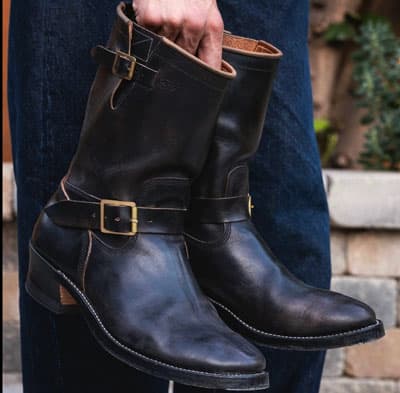
Defining Features:
- Mid-calf height
- Broad toe
- No laces; uses buckled straps
- Typically made of leather
Engineer boots are a type of pull-on leather boot, typically characterized by their mid-calf height, a rounded toe, and a single buckle strap around the ankle, with some models also sporting another at the top of the shaft.
Originally designed for train engineers in the US during the 1930s and ’40s, these boots provided protection from potential hazards while being easy to pull on and off.
Their sturdy construction and absence of laces made them particularly functional, and favorites among motorcycle riders (more on that below).
When and Where to Wear ‘Em:
- Casual outings or motorcycle rides
- Worn with jeans or leather pants
- Paired with leather jackets for a cohesive, rebellious look
Over the years, engineer boots have been embraced by various subcultures, from bikers to rock enthusiasts, due to their rugged appeal.
In a casual context, they pair well with jeans, t-shirts, leather jackets, and flannel.
They can also be matched with tailored trousers and button-down shirts for a more polished but still quite bad-ass look that’s both refined and rebellious.
Sharp Selections:
Motorcycle Boots
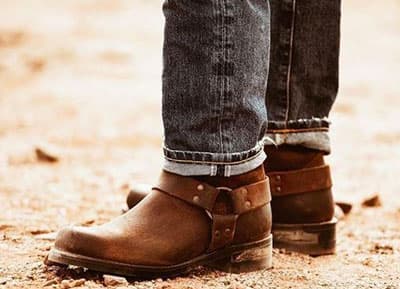
Defining Features:
- Designed for riding motorcycles
- Durable and often heavy-duty
- May include reinforcements at the ankle, toe, and heel
- Usually has a non-slip sole
Motorcycle boots are specifically designed footwear for motorcyclists, prioritizing safety, protection, and grip while riding.
Typically made of durable brown or black leather, these boots often feature reinforced toe and heel areas, ankle protection, and non-slip soles.
Their design aims to shield the rider from the heat of the bike, potential impacts, and the road while also providing stability and grip when resting the foot on the ground or controlling foot levers.
When and Where to Wear ‘Em:
- Motorcycle riding or casual wear
- With protective gear or leather jackets
- Paired with jeans or riding pants
While their primary function is for riding, their rugged and stylish looks make it all too tempting to wear motorcycle boots in casual settings.
They pair well with jeans, leather jackets, and casual shirts, and can be a real statement piece that punches up an otherwise standard casual getup.
But as with cowboy boots, be careful here.
If you don’t ride but you love motorcycle boots, you run the risk of getting called out by real motorcyclists, who might not love seeing their bad-assery appropriated.
Sharp Selections:
Wait, what’s the difference…?
Engineer Boots vs Motorcycle Boots
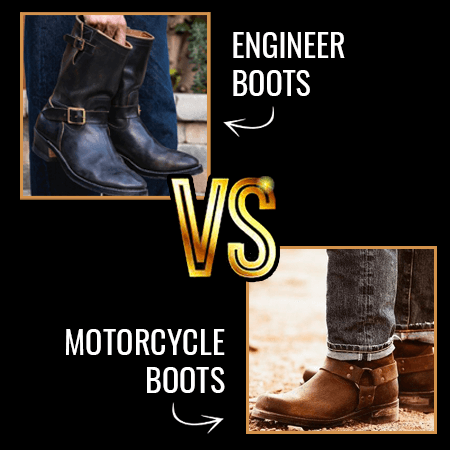
While both have become favorites among motorcyclists, engineer boots and motorcycle boots have distinct origins and features.
Engineer boots were originally designed for railroad workers in America.
Their pull-on style, characterized by buckled straps at the ankle and shaft, combined with a rounded toe and mid-calf height, inadvertently (but advantageously) made them suitable for bikers.
The absence of laces, which could get entangled in bike parts, and their durable, chemical-resistant soles further contributed to their popularity among riders.
On the other hand, motorcycle boots are purposefully crafted for motorcycling.
They come in diverse styles, from lace-up to pull-on, and can range from ankle-length to above the calf.
What sets them apart is their design emphasis on rider safety.
Their soles offer excellent traction, and many feature reinforcements at the ankle, toe, and heel, along with added functionalities like metal armor inserts and shifter pads.
While both boots serve riders, motorcycle boots offer a broader range of protective features tailored to the nuances of biking.
So, uh, which ones should I wear?
By modern standards, both styles look pretty bad-ass.
But as mentioned above, wearing motorcycle boots when you don’t actually ride runs the significant risk of making you look like a poser, which is never a good idea.
(And that’s especially true when you’re appropriating a look from guys known for their rebellious nature and, shall we say, less-than-reverent relationship with the law.)
So if you like the look but don’t actually ride motorcycles, I definitely recommend opting for engineer boots.
Rain Boots
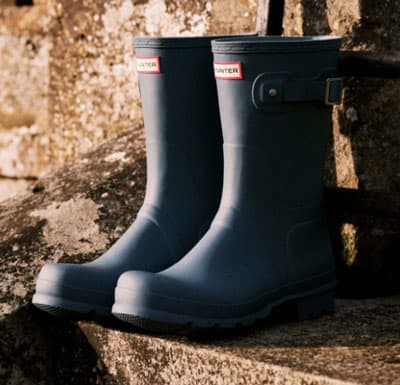
Defining Features:
- Typically made entirely of waterproof material, like rubber
- Knee-high or calf-length
- Designed to keep feet dry during rainy conditions
Also known as wellingtons – or simply “wellies” – rain boots are waterproof boots traditionally made of rubber or polyvinyl chloride (PVC).
Designed primarily to keep feet dry during wet weather, they usually have a slip-on design, extending up to the calf or knee.
Their simplistic design is paired with thick rubber soles, ensuring both water resistance and good traction on wet surfaces.
When and Where to Wear ‘Em:
- Rainy days or wet conditions
- With raincoats or waterproof jackets
Whereas duck boots serve a similar purpose but have been adopted by some as a style choice, rain boots are more about function than form.
These are the boots you throw on when it’s pouring for hours, the puddles are as high as your ankles, and you don’t really care about how your feet look, you just want to keep them dry as you make a mad dash for home.
Sharp Selections:
Snow Boots
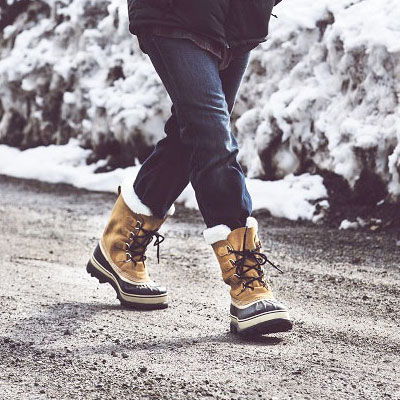
Defining Features:
- Insulated for warmth
- Made of water-resistant or waterproof materials
- High traction soles for slippery conditions
- Often taller to prevent snow from entering the boot
Snow boots, also called winter boots (for obvious reasons), are insulated footwear designed specifically to keep feet warm and dry in cold, snowy conditions.
Typically made with waterproof materials, these boots have a high-cut design, often reaching the mid-calf or higher.
Like rain boots and duck boots, they feature thick, rubberized soles with deep treads to provide traction on snowy or icy surfaces.
But they also have insulating materials like faux fur or thermal linings, which help keep your feet not just dry, but warm.
When and Where to Wear ‘Em:
- Snowy, cold conditions
- Paired with other winter fashion like parkas and thermal wear
- With woolen socks for added warmth
This one is pretty straightforward.
Snow boots are indispensable for the wintry conditions of colder months, be it in urban settings or snowy terrains.
In cities with harsh winters, you can wear them on those really snowy days when it’s up to your ankles and no other footwear really makes sense.
And if you’re wearing snow boots, chances are good that you’re also wearing a parka or some other kind of warm winter jacket.
Sharp Selections:
Next Up ↓
The Best-Looking Men’s Boot Styles
Breaking Down the Most Stylish Versions of Each Boot Type
Dress Boots
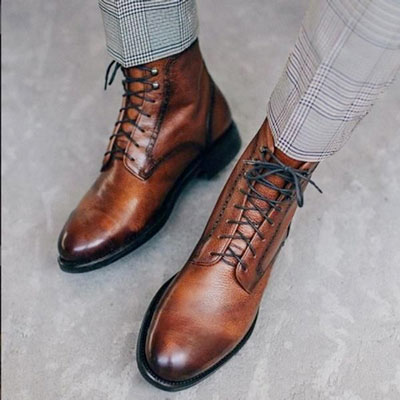
Defining Features:
- Sleek toe shape
- Solid construction and premium materials
- Usually made with a leather sole, or a thin rubber sole that still looks refined (rather than rugged)
The term dress boot refers to any boots that have the refined toe shape and sleek look of dress shoes.
Often made of premium materials like leather or suede, they closely resemble dress shoes in design and finish but have a higher shaft.
“If they’re actually boots but at first glance they look like dress shoes, then they’re dress boots.“
Essentially, they combine the ankle-length construction of boots with the sophistication and construction of dress shoes, which allows them to be worn at formal and semi-formal events where other boots would be too casual.
The reason why dress boots is a style and not a type of boot is that a lot of different types of boots could be considered dress boots, including Oxfords, Chelseas, chukkas, as could some of the styles listed below, like plain toes, cap toes and brogues.
So “dress boot” is kind of like a master category that could be understood this way:
If they’re actually boots but at first glance they look like dress shoes, then they’re dress boots.
Plain Toe Boots
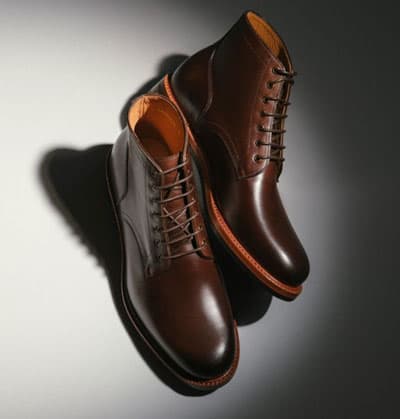
Defining Features:
- Unadorned and smooth toe box
- Can be casual or dressy depending on material and design
- No cap, brogueing, or moccasin stitching on the toe
The phrase plain toe boots refers to boots that have an unadorned and seamless toe box at the front of the shoe.
Whereas cap toe or wingtip boots (both of which are explained below) have distinct decorative seams or detailing on the toe, plain toe boots offer a clean, uninterrupted look.
Their minimalistic design gives them a versatile appeal, which is why you can find everything from dressy leather black boots to hardcore work boots with a plain toe.
Cap Toe Boots
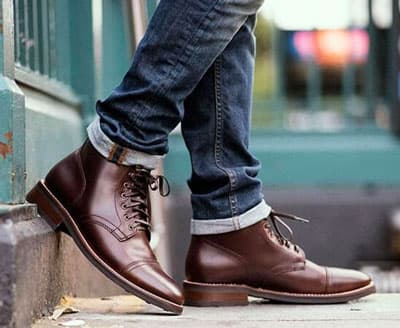
Defining Features:
- Feature a distinct “cap” over the toe box
- The cap is a piece of leather stitched over the toe area
- Can be found in both dressy and casual styles
Cap toe boots are distinguished by a horizontal piece of material (the titular “cap”) that overlays the toe box, providing both reinforcement and a decorative touch.
This design feature creates a noticeable seam across the toe, adding an element of style and often additional stitching or broguing details.
The cap toe was initially developed for added durability, which is why you frequently see it on purpose-specific boots like work boots and service boots, with the much-loved Red Wing Iron Ranger being a prime example.
But it’s since become a classic design element that nicely blends function and fashion, so today you can find it on everything from work boots to dress boots.
Cap toes can also be combined with one or more other styles on this list, creating a sort of hybrid.
For instance, some cap toes have broguing patterns that give them an added bit of distinction, and a cap toe – with or without broguing – can be found on just about any boot type, including Oxfords, Chelseas, chukkas and more.
Moc Toe Boots
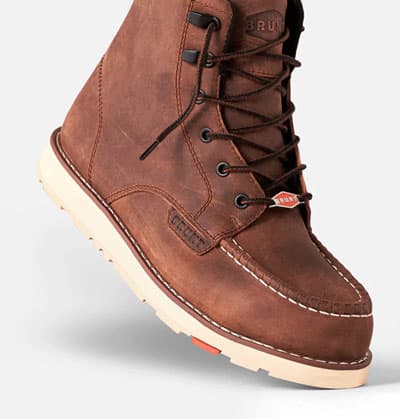
Defining Features:
- Toe design features moccasin-like stitching, often in a squared off or U shape
- Can be casual or work-oriented
- Commonly found in leather or suede
Moc toe boots feature a moccasin-style design on the toe, characterized by a prominent seam that encircles the toe’s top, creating a U-shaped design.
This unique stitching detail has its origins in Native American footwear, where the moccasin construction was favored for its comfortable fit and functional design.
In modern footwear, the moc toe design offers both comfort and a distinct aesthetic, and it’s most often found in work boots and casual boots.
But it’s worth noting that the bulkier construction and square or U-shaped toe definitely makes these a more casual style.
I’ve got a pair of Brunt work boots, the Marins, that have a moc toe but not a lot of extra safety features, and they’re perfect for pairing with jeans and a puffer vest on colder fall days where I want something with a little heft, but don’t need a full snow boot.
Brogue Boots
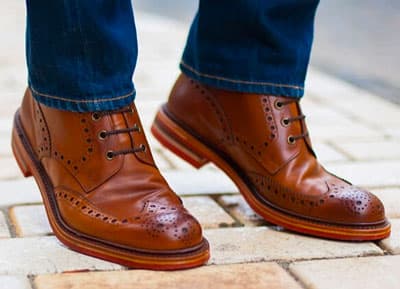
Defining Features:
- Characterized by decorative perforations (brogueing) and serration along the pieces’ visible edges
- Can be full brogue (wingtips) or have the brogueing limited to certain areas
- Often made of leather
Brogue toe boots, also called wingtip boots, are characterized by the decorative perforations (or “broguing”) and serration along the visible edges of the material.
Originally, these perforations had a functional purpose in Scottish and Irish shoe designs, allowing water to drain from shoes when crossing wet terrains.
(In fact, the name “brogue” is derived from the Gaelic word brog, meaning shoe.)
Over time, broguing became a sought-after decorative detail in men’s footwear, with the toe area often being heavily adorned.
Depending on the extent and pattern of broguing, boots can be categorized as full brogues (or wingtips), semi-brogues, quarter brogues, and more.
While brogues started out as purpose-specific shoes designed for trudging through bogs, nowadays you can find them in a wide range of styles, including sleek leather-soled brogue dress boots and heavy, sh*t-kicking brogues with a thick lug sole.
I have more pairs of brogue boots than I care to admit (and far more than my wife would like me to have…) because they’re a timeless, masculine and versatile style that can be worn with almost anything.
More Resources ↓
More Advice on Stylish (and Sh*t-Kicking) Men’s Boots:
- The Best Men’s Chukka Boots Available Online
- In-Depth Thursday Boots Review
- The Absolute Most Comfortable Work Boots
- The Most Stylish Casual Boots to Wear with Jeans
- The 9 Best Red Wing Boots for Men to Own
- The 21 Most Supportive Insoles for Work Boots
- The Best Men’s Sneaker Boot Hybrids
- The Most Comfortable Steel Toe Boots for Standing All (Damn) Day
- In Review: Johnston & Murphy’s Karnes Cap Toe Boot
- The 11 Most Comfortable Mens Chelsea Boots
More Advice on Stylish Men’s Shoes:
- The 33 Best Men’s Dress Shoe Brands
- The Most Stylish & Essential Types of Shoes for Men
- The Best Men’s Shoes for Plantar Fasciitis
- The Best Men’s Shoes for Standing All Day
- The Absolute Best Shoes (& Shoe Colors) to Wear with Khakis
- The Most Comfortable Golf Shoes for Walking the Course
- The Most Stylish, Comfortable & Best Shoes for Male Teachers
- Our Favorite Cap Toe Oxford Dress Shoes for Men
- The (Absolute) Best Monk Strap Shoes for Men
- The Must-Have Mens Fall Shoes for When the Weather Turns
- The Best Red Bottom Dress Shoes for Men
- The Best Shoes for Men to Wear with Joggers
- The Most Stylish & Comfortable Pair of Men Dress Shoes
- The Most Stylish Shoes for Men to Wear with Jeans
- 10 of the Comfiest White Sneakers for Men
- The (Absolute) Best Chelsea Boots for Men
